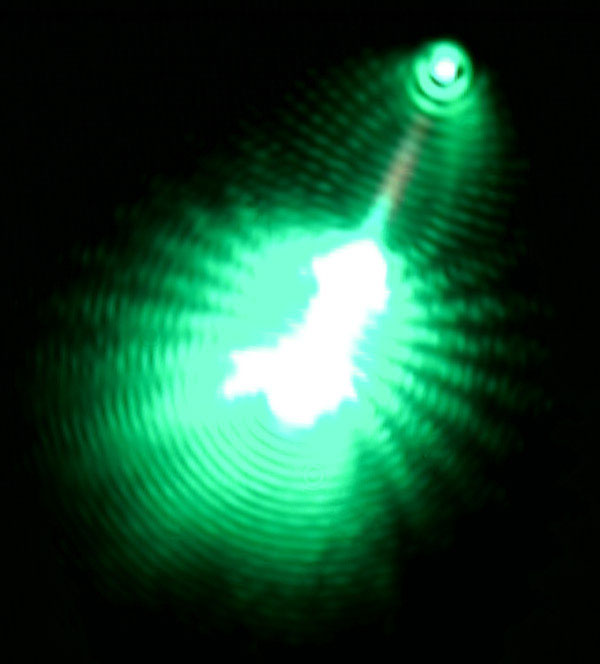First all-optical nanowire switch
September 10, 2012

Laser light is emitted from the end of a cadmium sulfide nanowire. (credit: University of Pennsylvania)
University of Pennsylvania researchers have made an important advance in photonics, creating the first all-optical photonic switch out of cadmium sulfide nanowires and combining these photonic switches into a logic gate, a fundamental component of computer chips that process information.
The research team’s innovation built upon their earlier research, which showed that their cadmium sulfide nanowires exhibited extremely strong light-matter coupling, making them especially efficient at manipulating light.
This quality is crucial for the development of nanoscale photonic circuits, as existing mechanisms for controlling the flow of light are bulkier and require more energy than their electronic analogs.
The research was conducted by associate professor Ritesh Agarwal and graduate student Brian Piccione of the Department of Materials Science and Engineering in Penn’s School of Engineering and Applied Science. Post-doctoral fellows Chang-Hee Cho and Lambert van Vugt, also of the Materials Science Department, contributed to the study.
“The biggest challenges for photonic structures on the nanoscale is getting the light in, manipulating it once it’s there and then getting it out,” Agarwal said. “Our major innovation was how we solved the first problem, in that it allowed us to use the nanowires themselves for an on-chip light source.”
Building a nanowire photonic switch
The research team began by precisely cutting a gap into a nanowire. They then pumped enough energy into the first nanowire segment that it began to emit laser light from its end and through the gap. Because the researchers started with a single nanowire, the two segment ends were perfectly matched, allowing the second segment to efficiently absorb and transmit the light down its length.
“Once we have the light in the second segment, we shine another light through the structure and turn off what is being transported through that wire,” Agarwal said. “That’s what makes it a switch.”
The researchers were able to measure the intensity of the light coming out of the end of the second nanowire and to show that the switch could effectively represent the binary states used in logic devices.
“Putting switches together lets you make logic gates, and assembling logic gates allows you to do computation,” Piccione said. “We used these optical switches to construct a NAND gate, which is a fundamental building block of modern computer processing.”
A NAND gate, which stands for “not and,” returns a “0” output when all its inputs are “1.” It was constructed by the researchers by combining two nanowire switches into a Y-shaped configuration. NAND gates are important for computation because they are “functionally complete,” which means that, when put in the right sequence, they can do any kind of logical operation and thus form the basis for general-purpose computer processors.
“We see a future where ‘consumer electronics’ become ‘consumer photonics,’” Agarwal said. “And this study shows that is possible.”
The research was supported by the U.S. Army Research Office and the National Institutes of Health’s New Innovator Award Program.